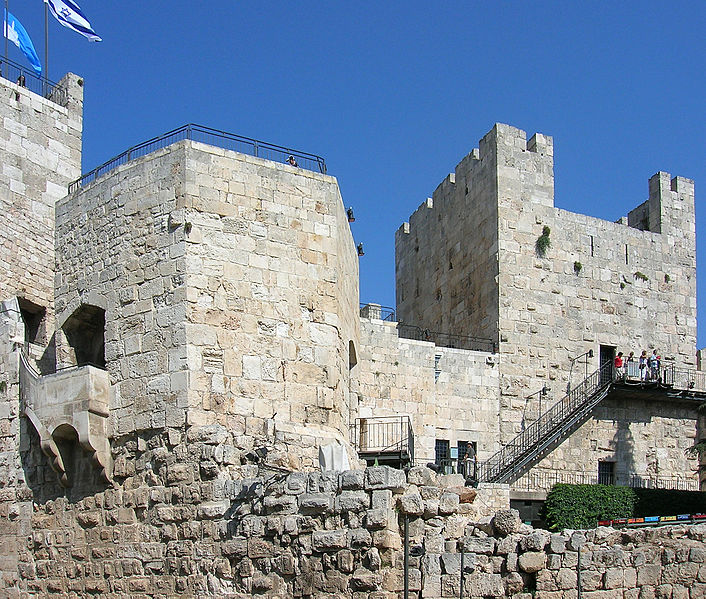17 Apr. Jesus is taken to the Roman governor’s residence
"Then the whole group stood up and led Jesus to Pilate. They began to accuse Jesus saying, 'We caught this man telling things that mislead our people. He says that we should not pay taxes to Caesar, and he calls himself the Christ, a king.'"
"Pilate asked Jesus, 'Are you the king of the Jews?'"
"Jesus answered, 'Those are your words.'"
"Pilate said to the leading priests and the people, 'I find nothing against this man.'"
"They were insisting, saying, 'But Jesus makes trouble with the people, teaching all around Judea. He began in Galilee, and now he is here.'"
"Pilate heard this and asked if Jesus was from Galilee. Since Jesus was under Herod's authority, Pilate sent Jesus to Herod [Antipas], who was in Jerusalem at that time."
"When Herod saw Jesus, he was very glad because he had heard about Jesus, and had wanted to meet him for a long time. He was hoping to see Jesus work a miracle."
"Herod asked Jesus many questions, but Jesus said nothing."
"The leading priests and teachers of the [Jewish] law were standing there, strongly accusing Jesus. After Herod and his soldiers had made fun of Jesus, they dressed him in a kingly robe and sent him back to Pilate."
(Luke 23:1-11)

At around 7.00am on Friday 7 April in 30AD ('Good Friday'), Jesus was taken to Herod the Great’s Palace, which served as the Praetorium (the Roman governor’s residence) when the governor was visiting Jerusalem (see 4 on the map on 10 April).
Pilate was the Roman procurator (governor) of the Roman province of Judaea, appointed by the emperor in Rome. He lived in Caesarea, the capital of the Roman province, but when he was in Jerusalem he resided at Herod the Great’s Palace, which served as the ‘praetorium’ or governor’s palace after Herod had died and Judaea came under direct Roman rule when Herod's son Archelaus was deposed in 6AD. Today, the 'Citadel', near the Jaffa Gate in Jerusalem, contains the only remnant of Herod’s Palace still standing today.
Early Christian pilgrims to Jerusalem believed that Pilate lived in the Antonia Fortress – which had been erected at the north west corner of the Temple Mount by Herod the Great (and named after the Roman general Mark Antony who had granted him favours).
As a result, the 'Via Dolorosa' - the 'Way of Tears', commemorating Jesus's walk to Calvary - runs from the Antonia Fortress to the Church of the Holy Sepulchre (while Jesus's route to Calvary actually went from Herod's Palace to the Hill of Calvary (see 7 on the map).
As the Jews knew that the Romans would not agree to execute a man for a Jewish religious crime such as blasphemy, the Jewish leaders claimed they had found Jesus guilty of a political crime – opposing the emperor and Roman rule.
They claimed that Jesus had taught the Jewish people to withhold their tax payments to the Roman authorities. But, in fact, Jesus had told the people to "give to Caesar what is due to Caesar, and give to God what is due to God" (see Luke 20:20-26).
Pilate asked Jesus if he was ‘the King of the Jews’ – a title used in mockery, as the Kingdom of Judaea had been abolished when the Romans deposed Archelaus in 6AD. Jesus neither confirmed nor denied the title, but merely said these were Pilate's own words (see Luke 23:3).
Pilate told the chief priests that he thought Jesus was innocent of the charges brought against him. He clearly wished to get rid of Jesus without further ado.
When Pilate learnt that Jesus was a Galilean, he then sent him to Herod Antipas, the tetrarch (ruler) of Galilee and Peraea (who had executed John the Baptist two years earlier) (see Mark 6:16-20). Herod was visiting Jerusalem for the Passover festival and staying nearby at the Hasmonaean Palace, built for the Jewish kings of the Hasmonaean dynasty in the 1st century BC (see 5 on the map).
Jesus refused to talk to Herod, whose soldiers mocked him and dressed him in a splendid robe. So at around 7.30am, Jesus was taken back to Pilate’s residence at Herod’s Palace for further questioning.
The photo (by EdoM) shows the Tower of Phasael in the Jerusalem 'Citadel', the only remaining part of Herod the Great's palace still standing today.
You can find out more about the events of Holy Week @ https://www.thebiblejourney.org/…/6-jesuss-last-journey-to…/
